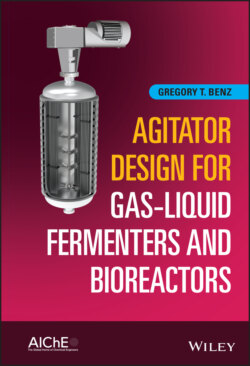Читать книгу Agitator Design for Gas-Liquid Fermenters and Bioreactors - Gregory T. Benz - Страница 12
Оглавление
Foreword for Greg Benz
Bioreactor agitator engineering is a broad mosaic. The image is simple and clear from a distance, but as the viewer moves closer, a multitude of distinct individual pieces come into view. Likewise, several diverse disciplines converge in this specialized field: microbiology, transport phenomena, machine design, metallurgy, and reliability engineering. During a project, this list is expanded to include manufacturing and procurement. For the practitioner, the challenge is significant. What information is important? What solutions are time‐tested? What are the common pitfalls? How should all of these pieces be assembled into a unified design?
There are many books and articles available on the design of agitators and bioreactors. However, when the time comes to prepare drawings and make purchases for an actual project, it becomes apparent that those resources are missing large swaths of practical information to guide the reader’s design choices. How are bioreactor agitators designed in real life? This comprehensive book addresses both the broad background and the small details needed to deliver a good project, from design through delivery.
I was excited to learn that Greg Benz was writing this book. We have worked together for many years designing equipment for bioprocessing facilities, from cellulosic ethanol to enzyme production to hydrogen‐rich gas fermentation. He has been a trusted mentor and a patient teacher.
Greg is an accomplished practitioner, a true craftsman. His career has spanned the full scope of the design, manufacturing, and operation of mixing systems, with a special focus on gas–liquid systems for bioreactors. Through his years at Chemineer, and later as a well‐known and respected mixing consultant, he has perhaps overseen more bioreactor agitator designs than anyone in the field. His expertise helped to establish industrial biotechnology as a mature industry.
During our years working together, Greg has offered insight on many questions not generally answered in fermentor design books, such as: What is the best way to seal a shaft? What is better: small, fast agitators or big and slow? What are the most common failure modes? Is metal surface polishing really necessary in comparison with other contamination sources? How much polish? What are the most common failure modes? How much overdesign should be included? Bubble columns versus stirred tanks? What are the latest innovations? How does fed‐batch impact agitation design? What information should we gather at pilot scale to ensure commercial‐scale success? How should the fermenter be controlled to maintain a dissolved oxygen level: vary the air or vary the motor speed? How do agitation performance and power draw change if the mixer is on speed control? How are baffles designed? How do we clean underneath an impeller? How can thermal expansion be handled during cleaning and steam‐in‐place? What heat transfer coefficient should we expect from internal coils? External jackets? What vendors are reliable? How do we install this equipment, anyway?
Until now, answers to these questions have been difficult to find, making this book a treasure trove for a practicing engineer. Additionally, this valuable information will fuel the progress of biotechnology, which provides food and energy resources to people around the world.
Few engineers possess Greg's wealth of expertise and fewer still take the time to meticulously summarize their knowledge for the benefit of future generations. That he did so makes me very glad.
Keith Flanegan, P.E.IdeaCHEM, Inc.September 2020
